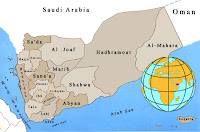Shabwa: Hadhramout's Western Neighbor
 There is the old Shabwa city, which was the old capital of Hadhramaut; and there is present day Shabwa (Shabwah), which is the main neighboring province, west of Hadhramaut. Of the ancient Shabwa city, the ruins can still be found at the furthest end, southwards, of the Hadhramout/Do'an valley and at the foothill of the Hadhramout Plateau; it is where archaeologists made the largest and most extensive discovery ever of a temple, in the Arabian Peninsula. There, in ancient Shabwa - traders, from near and far, used to gather in or pass through. Of present day Shabwa, it is a land of rugged mountains and valleys in the south; and stretches north, in to the vast desert of Rub'al Khali.
There is the old Shabwa city, which was the old capital of Hadhramaut; and there is present day Shabwa (Shabwah), which is the main neighboring province, west of Hadhramaut. Of the ancient Shabwa city, the ruins can still be found at the furthest end, southwards, of the Hadhramout/Do'an valley and at the foothill of the Hadhramout Plateau; it is where archaeologists made the largest and most extensive discovery ever of a temple, in the Arabian Peninsula. There, in ancient Shabwa - traders, from near and far, used to gather in or pass through. Of present day Shabwa, it is a land of rugged mountains and valleys in the south; and stretches north, in to the vast desert of Rub'al Khali.Old Shabwa city, is on a hilly area; ruins - enclosed by a wall and large buildings with columns and statues still exist. Archaeologists - French and Italian, after extensive excavations and studies, revealed that the site - as early as in the second millennium BC, had an agricultural economy based on seasonal irrigation. It is due to such discoveries that Yemen is often referred to as the cradle of Arab civilization; and evidence of mankind’s earliest existence can still be found in Yemen today. Indeed, the archeological history of Yemen virtually parallels that of humanity. Prehistoric artifacts have been found in the country, in the form of stone tools and hand axes which are associated with the early human species Homo erectus. In Darbas, at the outflow of the Wadi Jardaan (Jardaan Valley) - an ancient, pre-Islamic settlement, with a field system and several irrigation structures, were discovered in 2005; this settlement, most probably Hadhramitic, dates back to the 1st millennium BC.
By the 8th or 7th century B.C. - it seems that a new population, probably of Sabaeans, migrating from Hadramaut, brought into Shabwa, new traditions in architecture, decoration and pottery. These migrants settled down in the old villages and towns, and gradually mixed with the native population. Shabwa grew and rose - with walls and houses mainly built of stones and lime; it became the residence of the rulers of Hadramaut and became their capital too; for Hadhramaut and the Hadharem - it is most probably their first urban center before Shibam. The Hadhrami sultans and kings, ruled Hadhramout from there. Shabwa became the center of the frankincense and the incense trade; a trade that extended to as far as Syria, Egypt, Rome and all the way to India and China. The old city, is now no more but ruins; except for its salt deposits which is still mined today using simple tools; very much like in ancient times when it was also mined and traded. Other ancient sites in Shabwa are: the old city of Tamna'a, Hajar bin Hameed and Mablaqah route; all these rose due to the trade and prominence of the incense trade.
Modern day Shabwa, is a sparsely populated province. Ataq, its capital - like Mukalla - of late, has grown and expanded rapidly. It is located on a flat, barren area; due to its high elevation, a range of mountains between it and the coast and its distance from the sea, it is cool and humidity free most of the year. On the coast, Shabwa has a number of beautiful beaches, like Bir Ali - which has been a fishing port from time immemorial; close to Bir Ali, are the Radhoum springs, which are the largest and main medicinal hot springs in Yemen. Shabwa has other urban centers where its population is concentrated, like: Beiyhaan, May'fae, Habbaan and Azzaan. Many people still keep goats and sheep, especially in the valleys and sandy deserts. In Wady Jardaan, like in Wady Do'an, for hundreds of years, people have kept bees and produced excellent honey; the only honey said to compete with the reputedly best honey in the world of Wady Do'an.
Though Shabwa's people are more tribal and more conservative in their ways, there is a striking similarity between the people of Shabwa and those of Hadhramout, especially on its eastern side bordering Hadhramaut: they are very conservative; and their appearance, culture, tradition, way of dressing, food and most of their last-family names, like in Hadhramout, start with a 'Ba' or a 'Bin' or an 'Al'. Mukalla has a large population of people and families from Shabwa; they, like people from Mahra, very easily fit in and assimilate with the Hadharem.
+ Shabwah on Google Maps


Comments